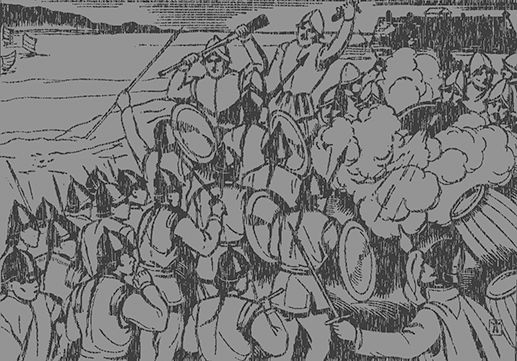A confederacy of pirates and ronins against Hispanic Manila

A long, long time ago, when the southern coast of China was plagued by marauding pirates, a notorious figure named Limahong rose to infamy. Driven away by the Chinese fleet, Limahong and his crew sought refuge southward, towards the Philippine islands. Along the way, they commandeered a trading vessel bound for China, learning of Manila—a Spanish outpost defended by 200 men. Seeing an opportunity, Limahong envisioned replacing the Spaniards with his own fleet of 60 junks, carrying about 6,000 men, women, and families, with the aim of establishing their own settlements there.
Limahong conspired with Japanese pirates, led by Shoko or Sioco, to challenge the Spanish presence in Manila.
The year was 1574. Manila had only been established by the Spaniards in 1571, following an expedition led by Martin de Goiti, under the orders of Miguel Lopez de Legazpi, who defeated the local forces of Raja Sulayman in the Battle of Manila on May 24, 1570. This marked the birth of Manila as the capital of the Philippine islands. Earlier, Ferdinand Magellan rediscovered the Philippines in March 1521, ultimately meeting his end in Mactan. Subsequently, the Spaniards established their first settlement in Cebu, making it their initial stronghold, complete with the first Catholic church in the country. From there, their gaze turned to Manila, prompting De Goiti's mission on behalf of the Spanish crown.
Meanwhile, Limahong dispatched Sioco and some 700 men for their initial assault on Manila. However, their journey was thwarted by rough seas, forcing them to land at Paranaque and proceed on foot towards Manila. As they neared Intramuros, they clashed with locals, sparking alarm within the city. De Goiti, though ailing and with few men at his disposal, attempted to repel the invaders but was overcome, leading to a tragic end as they valiantly defended Manila. News of the attack spread rapidly, reaching the garrison, prompting a swift response.
As Sioco's men advanced towards the walled city, they encountered Spanish resistance, though they ultimately overwhelmed their opponents until reinforcements arrived, forcing them to retreat to Cavite where they regrouped with Limahong.
A second assault was planned, but the Spanish garrison was prepared. Despite Sioco's attempts to confuse the Spaniards with a three-pronged attack, they failed to breach the defenses. Sioco perished in the attempt, and his forces were forced to withdraw.
While the Spanish forces fended off the pirates, they also quelled revolts elsewhere. Escaped slaves took refuge via the Pasig River, while locals in Tondo and Manila looted churches and held clergymen captive.
As Limahong's fleet waited in Paranaque, the Spaniards bolstered their defenses, summoning reinforcements from nearby islands. Juan de Salcedo, dubbed the "last of the conquistadores," negotiated with Raja Lakandula, securing his surrender and that of their hostages.
The conflict seesawed between the Spanish and Limahong's camps. Despite their numerical disadvantage, the Spaniards defended Manila fiercely, inflicting heavy losses on Limahong's forces. Before departing northward, Limahong plundered Paranaque and razed San Agustin Church in Intramuros. The decisive battle occurred in Pangasinan months later, where Salcedo's forces pursued and eventually routed Limahong's remaining troops.
There were reports of Chinese emissaries attempting to recruit Limahong, but he declined. Similarly, encounters with Chinese viceroy Wang Wanggao ended in narrow escapes. Some accounts suggest Limahong sought employment in Siam (Thailand) or India.
In retrospect, Limahong and his alliance of Chinese-Japanese pirates, possibly including ronin (masterless samurais), were the earliest challengers to Spanish control in the Philippines. This prompted the reinforcement of Manila's defenses and a reassessment of defensive strategies. Centuries later, Dutch, British, and German forces would attempt similar challenges, with varying degrees of success. Notably, the British briefly occupied Manila and Cavite, while the Americans ultimately wrested control from Spain in 1898. Thus, the tumultuous history of Philippine colonization unfolded, shaped by these early clashes and subsequent conflicts.